 W
WApoptosis is a form of programmed cell death that occurs in multicellular organisms. Biochemical events lead to characteristic cell changes (morphology) and death. These changes include blebbing, cell shrinkage, nuclear fragmentation, chromatin condensation, chromosomal DNA fragmentation, and global mRNA decay. The average adult human loses between 50 and 70 billion cells each day due to apoptosis. For an average human child between the ages of 8 and 14, approximately 20–30 billion cells die per day.
 W
WAsystole is the absence of ventricular contractions in the context of a lethal heart arrhythmia. Asystole is the most serious form of cardiac arrest and is usually irreversible. Also referred to as cardiac flatline, asystole is the state of total cessation of electrical activity from the heart, which means no tissue contraction from the heart muscle and therefore no blood flow to the rest of the body.
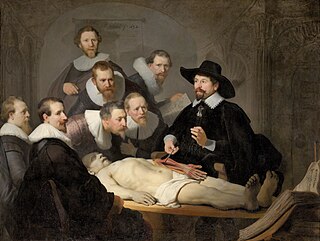 W
WAn autopsy is a surgical procedure that consists of a thorough examination of a corpse by dissection to determine the cause, mode, and manner of death or to evaluate any disease or injury that may be present for research or educational purposes.. Autopsies are usually performed by a specialized medical doctor called a pathologist. In most cases, a medical examiner or coroner can determine cause of death and only a small portion of deaths require an autopsy.
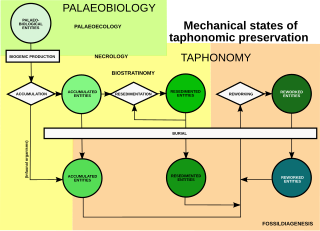 W
WBiostratinomy is the study of the processes that take place after an organism dies but before its final burial. It is considered to be a subsection of the science of taphonomy, along with necrology and diagenesis. These processes are largely destructive, and include physical, chemical and biological effects:Physical effects non-exhaustively include transport, breakage and exhumation. Chemical effects include early changes in mineralogy and oxidation. Biological effects include decay, scavenging, bioturbation, encrustation and boring.
 W
WBody donation, anatomical donation, or body bequest is the donation of a whole body after death for research and education. Donated bodies are mostly used for medical education and research. They are used for gross anatomy, surgical anatomy and for furthering medical education. For years, only medical schools accepted bodies for donation, but now private programs also accept donors. Depending on the program's need for body donation, some programs accept donors with different specifications.
 W
WCell death is the event of a biological cell ceasing to carry out its functions. This may be the result of the natural process of old cells dying and being replaced by new ones, or may result from such factors as disease, localized injury, or the death of the organism of which the cells are part. Apoptosis or Type I cell-death, and autophagy or Type II cell-death are both forms of programmed cell death, while necrosis is a non-physiological process that occurs as a result of infection or injury.
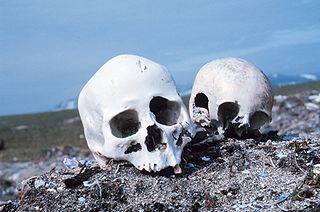 W
WForensic science, also known as criminalistics, is the application of science to criminal and civil laws, mainly—on the criminal side—during criminal investigation, as governed by the legal standards of admissible evidence and criminal procedure.
 W
WThe Gompertz–Makeham law states that the human death rate is the sum of an age-dependent component, which increases exponentially with age and an age-independent component. In a protected environment where external causes of death are rare, the age-independent mortality component is often negligible. In this case the formula simplifies to a Gompertz law of mortality. In 1825, Benjamin Gompertz proposed an exponential increase in death rates with age.
 W
WThe hot nose sign refers to increased perfusion in the nasal region on nuclear medicine cerebral perfusion studies in the setting of brain death. The absent or reduced flow in the internal carotid arteries is thought to lead to increased flow within the external carotid arteries and subsequent increased perfusion in the nasal region.
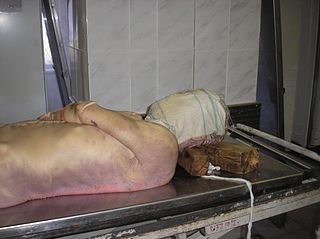 W
WLivor mortis, postmortem lividity, hypostasis or suggillation, is the fourth stage of death and one of the signs of death. It is a settling of the blood in the lower, or dependent, portion of the body postmortem, causing a purplish red discoloration of the skin. When the heart stops functioning and is no longer agitating the blood, heavy red blood cells sink through the serum by action of gravity. The blood travels faster in warmer conditions and slower in colder conditions.
 W
WMaternal death or maternal mortality is defined by the World Health Organization (WHO) as "the death of a woman while pregnant or within 42 days of termination of pregnancy, irrespective of the duration and site of the pregnancy, from any cause related to or aggravated by the pregnancy or its management but not from accidental or incidental causes."
 W
WA morgue or mortuary is a place used for the storage of human corpses awaiting identification or removal for autopsy or respectful burial, cremation or other method. In modern times, corpses have customarily been refrigerated to delay decomposition.
 W
WMortality rate, or death rate, is a measure of the number of deaths in a particular population, scaled to the size of that population, per unit of time. Mortality rate is typically expressed in units of deaths per 1,000 individuals per year; thus, a mortality rate of 9.5 in a population of 1,000 would mean 9.5 deaths per year in that entire population, or 0.95% out of the total. It is distinct from "morbidity", which is either the prevalence or incidence of a disease, and also from the incidence rate.
 W
WNecroptosis is a programmed form of necrosis, or inflammatory cell death. Conventionally, necrosis is associated with unprogrammed cell death resulting from cellular damage or infiltration by pathogens, in contrast to orderly, programmed cell death via apoptosis. The discovery of necroptosis showed that cells can execute necrosis in a programmed fashion and that apoptosis is not always the preferred form of cell death. Furthermore, the immunogenic nature of necroptosis favors its participation in certain circumstances, such as aiding in defence against pathogens by the immune system. Necroptosis is well defined as a viral defense mechanism, allowing the cell to undergo "cellular suicide" in a caspase-independent fashion in the presence of viral caspase inhibitors to restrict virus replication. In addition to being a response to disease, necroptosis has also been characterized as a component of inflammatory diseases such as Crohn's disease, pancreatitis, and myocardial infarction.
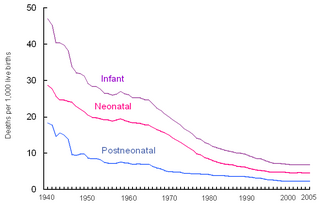 W
WPerinatal mortality (PNM) refers to the death of a fetus or neonate and is the basis to calculate the perinatal mortality rate. Variations in the precise definition of the perinatal mortality exist, specifically concerning the issue of inclusion or exclusion of early fetal and late neonatal fatalities. The World Health Organization defines perinatal mortality as the "number of stillbirths and deaths in the first week of life per 1,000 total births, that 22 completed weeks of gestation, and ends seven completed days after birth", but other definitions have been used.
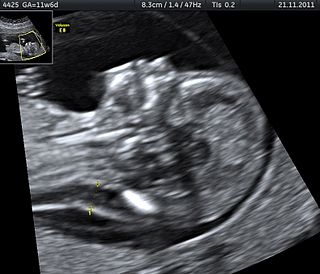 W
WStillbirth is typically defined as fetal death at or after 20 or 28 weeks of pregnancy, depending on the source. It results in a baby born without signs of life. A stillbirth can result in the feeling of guilt or grief in the mother. The term is in contrast to miscarriage, which is an early pregnancy loss, and live birth, where the baby is born alive, even if it dies shortly after.
 W
WThanatology is the scientific study of death and the losses brought about as a result. It investigates the mechanisms and forensic aspects of death, such as bodily changes that accompany death and the postmortem period, as well as wider psychological and social aspects related to death. It is primarily an interdisciplinary study offered as a course of study at numerous colleges and universities.